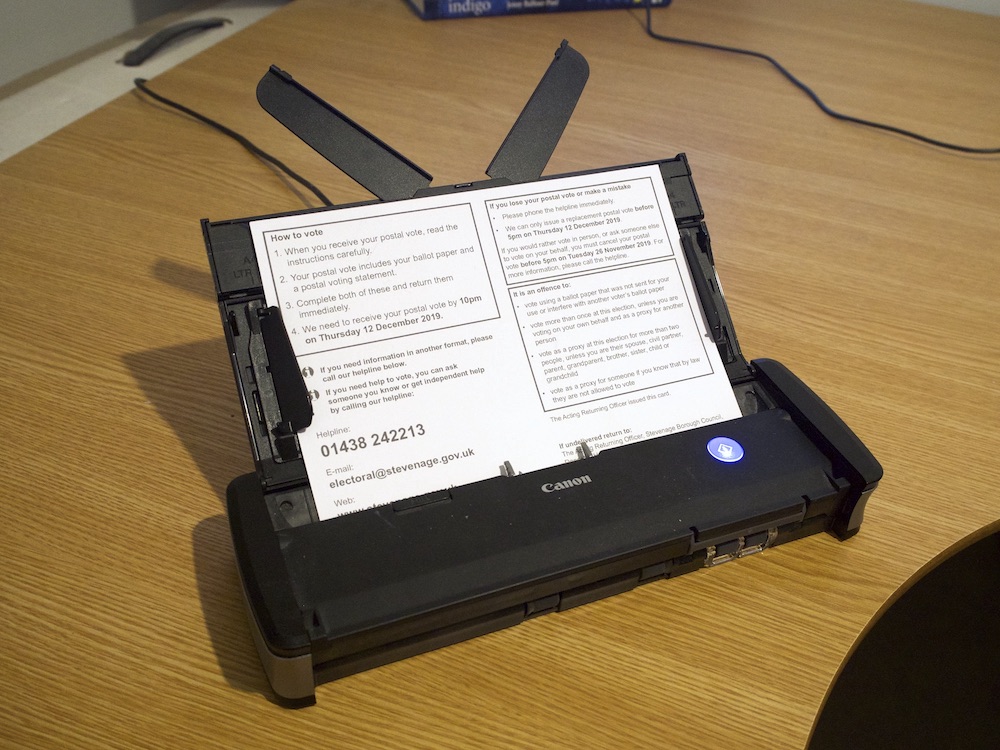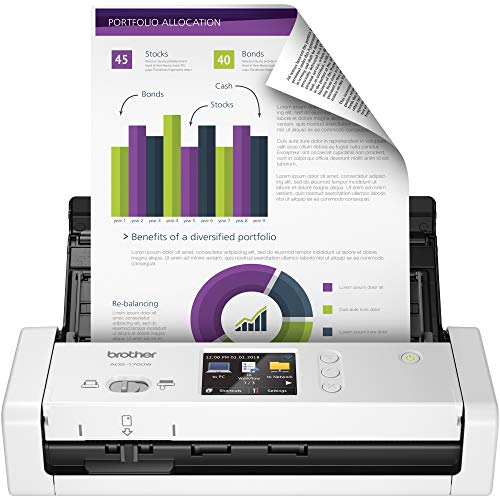Top 17 Best Scanners For Organizing Lots Of Papers Of 2024
Brandon Forder Apr 19, 2024 8:19 PM
Modern workplaces cannot tolerate piles of unnecessary paper since it is distracting and unsightly. You'll need heavy file cabinets or document containers if you have any prospect of discovering the documents you're looking for. When papers are digitized and indexed, they may be searched quickly. I use a computer scanner to archive important papers, receipts, and even my kids' artwork and other keepsakes. This way, I may delete anything guilt-free as recommended by Marie Kondo, and I'll have a wonderful digital scrapbook of memories to look back on in the future.
An efficient method of scanning documents quickly and easily is the first step on this path. For a long time, I relied on Fujitsu ScanSnap scanners, but I've tried and used several different models in businesses and as a reseller. I've gathered a list of the top scanners for document management in this post.

Compare Products
- SCORE8.8
- BrandEpson
- Prime
Last update on 2024-04-19 / Affiliate links / Images, Product Titles, and Product Highlights from Amazon Product Advertising API
Types of Scanners
Three out of the four most common scanners are particularly well-suited to preserving antique pictures. These include a digital camera, a flatbed scanner, and a film scanner. Let's get the most important stuff out of the way first. Determine what kind of scanner would work best for your materials.
Flatbed Scanner
The flatbed scanner is a typical home and workplace machine that most people think of when they imagine a scanner. The documents are laid flat on a fixed glass bed, hence the name "flatbed scanner." Watch this short video to get an idea of how a flatbed scanner works.
If you need a scanner that can handle both photo and document scanning with ease, a flatbed model is your best bet. This style of scanner works wonderfully for scanning items with texture, such as a business card stapled to an invoice.
Because they are full-sized scanners, no compromises had to be made in the creation of flatbed scanners, hence they offer an exceptionally high resolution. Scanners will display their resolution in dots per inch (DPI) (dots per inch). Scanners with resolutions of up to 600 dpi are available, while resolutions of 200 dpi or above usually work just fine. This isn't a major concern, though, because even budget scanners have plenty of pixel density to capture a clear image of your documents.
Sheet-Fed Scanner
Flatbed scanners are convenient for scanning a wide range of documents, but they fall short when it comes to volume. A sheet-fed scanner is the best solution if you need to scan multiple pages at once. You can scan numerous pages at once without manually switching the sheet in between scans using this document scanner.
Finding a sheet-fed scanner with excellent resolution is less important than finding one with excellent usability, dependability, and speed. Find a scanner that can handle heavy use, is reliable, and has a simple loading process. See how quickly a sheet-fed scanner can go to work in this example.
Portable Scanner
So, what do you do if you require scanning capabilities on the go? Relax; I have an answer for you. Mobile scanners may not be the most effective scanners, but they get the job done.
However, they provide sufficient resolution and are easy to use, even if they lack the greatest resolution, the largest sheet-feeder, and many other desirable conveniences. This was the perfect scanner for me to have as a student because I was constantly moving between the library and my apartment or the neighborhood coffee shop to get my work done.
Hybrid Scanners
Yes, it would be convenient to have a single device that can scan, print, and fax. Despite their versatility, hybrid scanners aren't great at any one thing. Most of these machines are a major pain to maintain because they constantly break down and require attention.
In addition, many of these devices have incredibly unpleasant peculiarities, such as a copy mode designed to scan and print exclusively to its own printer, or a scanning function that doesn't operate if the printer is out of ink/toner.
In most cases, you'd be better off spending the money on a dedicated scanner. We won't go into detail about these scanners because they're usually useless.
DADF (Duplexing Automatic Document Feeder)
The acronym DADF refers to a document feeder that can automatically handle both sides of a page.
With this function enabled, your scanner will routinely read both sides of a paper.
It also enables the scanner to automatically process piles of documents. That eliminates the need to manually insert paper sheets individually.
Every scanner needs DADF since it saves time and effort. It makes it easier to scan papers and increases output.
Scan Speed
How quickly you can scan documents is a function of the scan speed.
Pages per minute (PPM) is the unit of measurement. Scanning speeds are proportional to the PPM value, so a larger value means faster scanning.
A scanner with a PPM of 25 can scan a single page in 2.4 seconds. 50 pages per minute (PPM) scanners can scan a single page in about 1.2 seconds.
Type
Scanners can be categorized as either flatbed or sheet-fed.
Common types of scanners are flatbed scanners. This scanner model is the standard one most of us are familiar with.
Documents are placed between the scanning plate and the scanner door in a flatbed scanner.
There is no scanner door on sheet-fed scanners. The scanner is fed sheets of paper using a tray arrangement.
Sheet-fed scanners are more space- and time-efficient than their Flatbed counterparts.
If you frequently handle big works or need to complete projects rapidly, you may consider investing in a sheet-fed scanner.
If you need to scan photos or delicate papers, a flatbed scanner is your best bet.
Reliability
A high-quality scanner is an investment that will pay off with consistent results.
While high-quality scanners may seem pricey initially, they actually end up saving you money in the long term.
Low-cost scanners, those selling for less $100, don't stay long. You'll wind up spending more money on replacements.
The reliability of flatbed scanners is generally higher than that of sheet-fed scanners.
Sheet-feed scanners are more prone to jamming than other types of scanners because they have more folding and moving elements.
It's important to invest in a high-quality sheet-feed scanner if you're going to be using it frequently.
Multi-feed sheet detection
When an ADF pulls in two sheets at once by accident, this is called a multi-feed mistake, and it can ruin a scan or even ruin the original document. Sensors are a crucial part of any good scanner, as they allow for this kind of damage to be avoided.
Document scanning software
Scanning documents should be as simple as possible, and the bundled software should make labeling, sorting, and saving them just as simple.
Scan resolution
When scanning old or fragile documents, especially ones with faded print, image quality is of the utmost importance.
Color quality
While black and white scans are sufficient for most business documents, color scans of periodicals require high resolution for correct digitization.
Coverless scanning
Scanning huge amounts of documents quickly and digitizing surfaces of more irregularly shaped items are both facilitated by operating the scanner with its cover down.
Which scanner should I buy for my home?
For basic activities around the house, a flatbed scanner may be the best option. A portable scanner can make scanning documents much more convenient.
They aren't perfect, though. They don't make the best pictures, so you should think carefully about whether or not they'll suffice for your purposes.
Will I require a special-purpose scanner?
Buying a scanner requires careful consideration of your specific requirements. Standard scanners are adequate for most needs,
If you didn't put in the time or effort to make an informed decision, though, don't be afraid to use some serious scanning equipment.
How to Determine an Overall Good Photo Scanner?
High-resolution images with rich colors are hallmarks of a high-quality photo scanner. It ought to be inexpensive, straightforward, and equipped with dependable software to make scanning as simple as possible.
Purchasing a high-quality scanner for domestic use might be an excellent investment for those who value orderliness and cleanliness. With any luck, the advice we offered may help you keep your office or classroom neat and tidy.
There may still be some uncertainty as you make your final selection, despite the fact that I have recommended only the best items. So, I'll just make a fast recommendation.



























